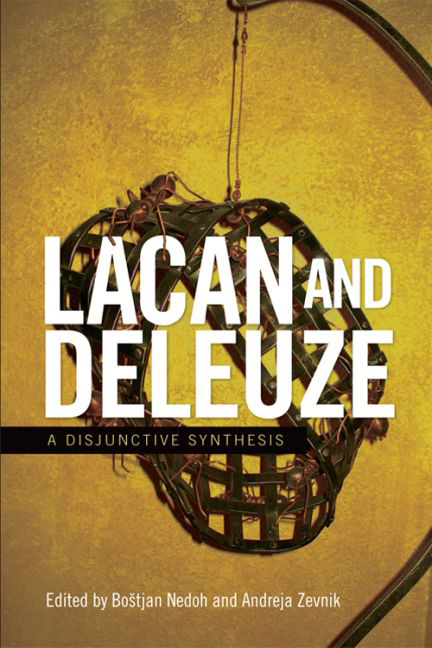Book contents
- Frontmatter
- Contents
- Acknowledgements
- Introduction: On a Disjunctive Synthesis between Lacan and Deleuze
- 1 For Another Lacan-Deleuze Encounter
- 2 Reciprocal Portrait of Jacques Lacan in Gilles Deleuze
- 3 Does the Body without Organs Have Any Sex at All? Lacan and Deleuze on Perversion and Sexual Difference
- 4 Gnomonology: Deleuze's Phobias and the Line of Flight between Speech and the Body
- 5 Lacan, Deleuze and the Politics of the Face
- 6 Denkwunderkeiten: On Deleuze, Schreber and Freud
- 7 Snark, Jabberwock, Poord'jeli: Deleuze and the Lacanian School on the Names-of-the-Father
- 8 Baroque Structuralism: Deleuze, Lacan and the Critique of Linguistics
- 9 Exalted Obscenity and the Lawyer of God: Lacan, Deleuze and the Baroque
- 10 The Death Drive
- 11 Repetition and Difference: Žižek, Deleuze and Lacanian Drives
- 12 Lacan, Deleuze and the Consequences of Formalism
- Notes on Contributors
- Index
2 - Reciprocal Portrait of Jacques Lacan in Gilles Deleuze
Published online by Cambridge University Press: 20 April 2017
- Frontmatter
- Contents
- Acknowledgements
- Introduction: On a Disjunctive Synthesis between Lacan and Deleuze
- 1 For Another Lacan-Deleuze Encounter
- 2 Reciprocal Portrait of Jacques Lacan in Gilles Deleuze
- 3 Does the Body without Organs Have Any Sex at All? Lacan and Deleuze on Perversion and Sexual Difference
- 4 Gnomonology: Deleuze's Phobias and the Line of Flight between Speech and the Body
- 5 Lacan, Deleuze and the Politics of the Face
- 6 Denkwunderkeiten: On Deleuze, Schreber and Freud
- 7 Snark, Jabberwock, Poord'jeli: Deleuze and the Lacanian School on the Names-of-the-Father
- 8 Baroque Structuralism: Deleuze, Lacan and the Critique of Linguistics
- 9 Exalted Obscenity and the Lawyer of God: Lacan, Deleuze and the Baroque
- 10 The Death Drive
- 11 Repetition and Difference: Žižek, Deleuze and Lacanian Drives
- 12 Lacan, Deleuze and the Consequences of Formalism
- Notes on Contributors
- Index
Summary
Once upon a time, there was the Marquis de Sade
No one was really surprised by the appearance of the 1967 winter issue of the journal Tel Quel – an important special issue on the work of the Marquis de Sade, in which one found the names of Pierre Klossowski, Roland Barthes, Hubert Damisch, Michel Tort and Philippe Sollers. Twenty years had passed since Klossowski's Sade, My Neighbour, published by Seuil, had inaugurated the lengthy process resulting in Sade being seen by the era's intelligentsia as the paragon of subversion. This process had consisted of numerous stages, the main one being the publication of the first modern edition of the marquis's oeuvre, which Jean- Jacques Pauvert had brought to the public's attention between 1947 and 1955 (this edition had led to numerous court cases, which he finally won through an appeal in 1957). In the meantime, Maurice Blanchot had published Lautréamont et Sade, Simone de Beauvoir ‘Must We Burn de Sade?’ in Les temps modernes, Georges Bataille Literature and Evil and the chapter ‘De Sade's Sovereign Man’ in Eroticism, and Foucault had dedicated numerous passages from his History of Madness and The Order of Things to the marquis. When the special issue of Tel Quel consecrated to ‘Sade's Thought’ was published, it had become evident to all those who kept abreast of the period's intellectual developments that the name Donatien Alphonse François de Sade numbered among those most able to produce the new in thought. The fact that this came from a dynamic of subversion – or rather, as Bataille put it, from a ‘transgressive’ one – only gave it more value. This is what gave it its modernity, insofar as modernity wanted above all to call into question all established order, as well as the foundations on which it claimed to rest, in order to reconcile it with the real. Moreover, this was the thesis of one of the most significant texts on Sade during this period: Jacques Lacan's article ‘Kant with Sade’, which was intended to serve as the preface to an edition of Philosophy in the Bedroom, and ultimately appeared in Critique in 1963, before being republished three years later in Écrits.
- Type
- Chapter
- Information
- Lacan and DeleuzeA Disjunctive Synthesis, pp. 32 - 43Publisher: Edinburgh University PressPrint publication year: 2017



